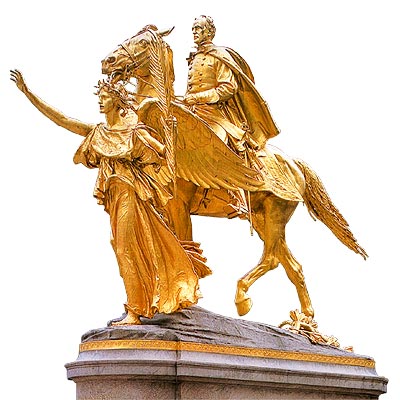 SKC Films Library |
| SKC Films Library >> Fine Arts >> Sculpture >> United States |
| Augustus Saint-Gaudens [sAnt gaw' dnz] best known for his monumental depictions of Civil War heroes, and for one of the rarest and most valuable of all U.S. coins
Augustus Saint- Gaudens was born in Dublin, Ireland, on March 1, 1848, the son of a shoemaker; his family immigrated to New York City while he was still an infant. He developed a love for art at an early age, and left school at the age of 13 to apprentice with a cameo cutter. During his apprenticeship he also studied drawing at Cooper Union and the National Academy of Design. In 1867, he went to Paris, where he studied at the École des Beaux-Arts. In 1870, he moved to Rome, where he established a studio. While in Rome he began his first full-length sculpture, Hiawatha (1871), based on the character made famous by James Fenimore Cooper. Returning to the United States in 1872, Saint-Gaudens built his reputation by completing portrait commissions for prominent New Yorkers. He also began working closely with architects, often creating works specifically for their sites. In 1877, Saint-Gaudens received his first major commission, a monument to Admiral David Farragut. Completed in 1881, and situated in an architectural setting designed by Stanford White, The Farragut Monument still stands in Madison Square Park, New York City. Over the subsequent years, Saint-Gaudens built a tremendous reputation based on his monumental depictions of several Civil War heroes, including General William Tecumseh Sherman (1892-1903), Central Park, New York City, and General John A. Logan (1894), Chicago. To this period also belong two very impressive monuments to President Abraham Lincoln in Chicago -- Standing Lincoln, in Lincoln Park (1884-1887), and Sitting Lincoln (1909), in Grant Park. One of his most impressive works is the Robert Gould Shaw Memorial (1884-1897). Located on Boston Common, the memorial features a procession of African-American foot soldiers of the 45th Massachusetts Volunteer Infantry with their commander, Colonel Shaw, on his horse with an angel of glory hovering above. General William T. Sherman, New
York City By 1900, Saint-Gaudens was suffering from cancer and had moved to Cornish, New Hampshire, site of what was originally his summer home. Before long he had attracted a small community of artists (popularly known as the Cornish Colony) that included painters Maxfield Parish, Thomas Dewing, George Deforest Brush and Kenyon Cox; architect and garden designer Charles Platt; sculptors Paul Manship and Louis Saint-Gaudens (his brother); and many others. In addition to portraits and monumental sculptures, Saint-Gaudens is also remembered for two coins he designed. In 1905, President Theodore Roosevelt commissioned him to redesign the ten- and twenty-dollar gold pieces. Today, the twenty-dollar gold piece he designed is one of the rarest, and most valuable, of all U.S. coins; the ten-dollar coin is also valuable, but not as rare. the 20-dollar gold piece designed by Saint-Gaudens Augustus Saint-Gaudens died of cancer on August 3, 1907. His Cornish home is now a National Historic Site. SOURCES SEE ALSO |
| SKC Films Library >> Fine Arts >> Sculpture >> United States This page was last updated on 10/06/2017. |


